

Explanatory Essay
Explanatory essay generator.
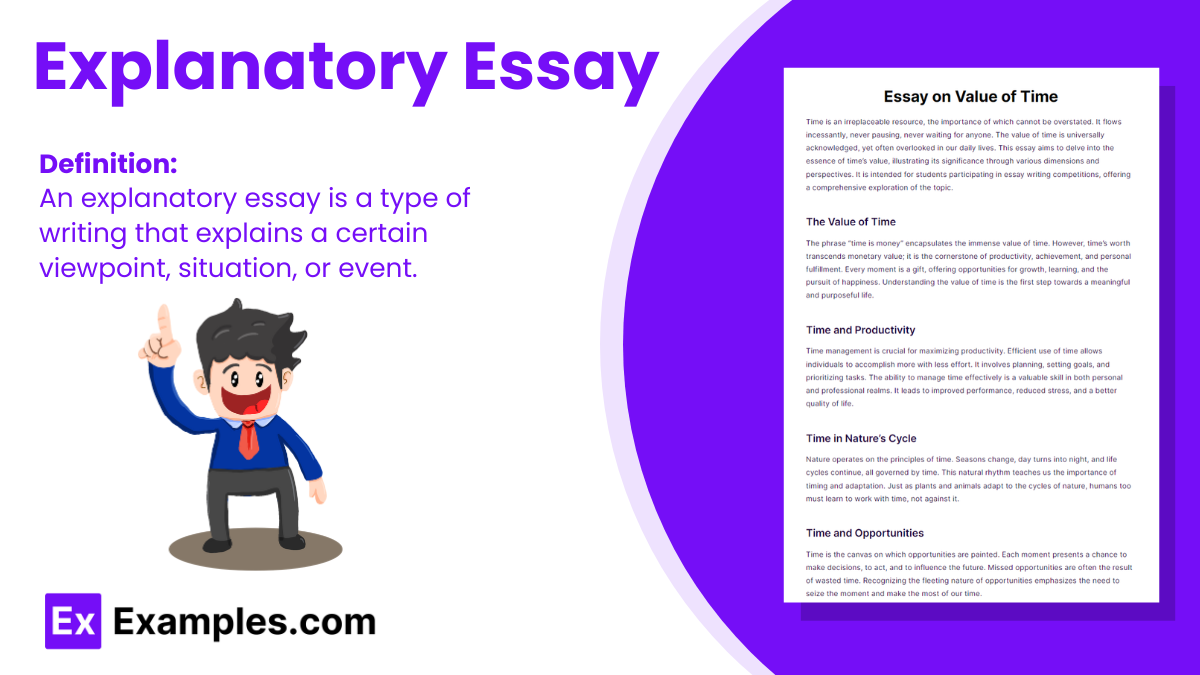
Essays Writing For a lot of students this word seems to get them to react in a very informal manner. In a way that they perceive this word or this activity as punishment from their professors. When it should not be seen as such. But what about you? What is the first thing that you can think of when you hear the word essays? For those who have gone through this type of discussion, you may have a different type of reaction compared to the majority of the population. Going back, we know that each kind of essay plays a different role and each essay has its own definition and uses. Of course we are not here to talk about the other types of essays except for the explanatory essay, also known as an expository essay. You know that an explanatory essay is also called an expository essay, But what is it about this kind of essay that makes it different from the rest? We know that there are uses for each but what about this? Is it from its term to explain? Are you curious enough to know what do you think this is about? If you are, check the article right now for more.
What is an Explanatory Essay?
An explanatory essay is a type of writing that explains a certain viewpoint, situation, or event. Unlike argumentative essays, which aim to persuade, explanatory essays focus on presenting information in a clear and straightforward manner, allowing readers to understand the topic without the writer’s bias. The goal is to explore a topic in detail by examining various perspectives and providing evidence, such as facts, examples, and statistics, to support the explanation. This essay type encourages critical thinking and research skills, as the writer must thoroughly understand and convey complex information to the audience effectively.
How to Write an Explanatory Essay
Here’s how to craft an effective explanatory essay:
- Understand the Prompt: Begin by thoroughly understanding the essay prompt or question. Identify the key aspects of the topic you need to explain.
- Choose a Topic: If you have the freedom to choose your topic, select one that is interesting and has enough information available for exploration.
- Conduct Research: Gather information from credible sources to gain a comprehensive understanding of your topic. Take notes on significant facts, statistics, and perspectives.
- Create an Outline: Organize your main points and evidence into an outline. This will serve as a roadmap for your essay, ensuring a logical flow of information.
- Write the Introduction: Start with a hook to capture the reader’s interest, followed by background information on your topic. Conclude the introduction with a clear thesis statement that outlines the main points of your explanation.
- Develop Body Paragraphs: Each body paragraph should focus on a single aspect of your topic. Start with a topic sentence that introduces the paragraph’s main idea. Provide evidence and facts to support your points, and explain how this information contributes to understanding the topic.
- Craft a Conclusion: Summarize the key points discussed in your essay and restate how they contribute to a deeper understanding of the topic. Avoid introducing new information in the conclusion.
- Review and Revise: After completing your first draft, take time to review and revise your essay. Check for clarity, coherence, and logical progression of ideas. Ensure that your essay adequately explains the topic without expressing personal opinions.
- Edit for Grammar and Style: Carefully proofread your essay for grammatical errors, punctuation, and spelling mistakes. Use clear and concise language to maintain the reader’s interest and understanding.
- Cite Your Sources: Properly cite all the sources you used to gather information. This adds credibility to your essay and avoids plagiarism.
Tips for writting an Explanatory Essay
- Begin with a clear understanding of the essay prompt to ensure your essay remains focused and relevant.
- Choose a topic that is both interesting and has sufficient information available for comprehensive exploration.
- Conduct thorough research from credible sources to gather diverse perspectives and facts about your topic.
- Create a detailed outline to organize your ideas and evidence logically, ensuring a coherent flow of information throughout the essay.
- Craft a compelling introduction that includes a hook to grab the reader’s attention, followed by background information on the topic and a clear thesis statement.
- Develop each body paragraph around a single main idea, using facts, examples, and explanations to support your points and enhance understanding.
- Ensure smooth transitions between paragraphs to maintain the flow of your essay and guide the reader through your explanations.
- Write a conclusion that summarizes the main points discussed, reinforcing the understanding of the topic without introducing new information.
- Maintain an objective tone throughout your essay, focusing on explaining the topic without inserting personal opinions or arguments.
- Review and revise your essay to improve clarity, coherence, and organization, and to ensure it adequately addresses the essay prompt.
- Proofread your final draft for grammatical, punctuation, and spelling errors to ensure your essay is polished and professional.
- Properly cite all sources used in your research to lend credibility to your essay and avoid plagiarism.
- Use clear and concise language to convey your explanations, making complex information accessible and understandable to your audience.
Important Steps for a Strong Explanatory Essay Conclusion
Creating a compelling conclusion for an explanatory essay is crucial for leaving a lasting impression on your readers. It’s the final chance to reinforce your thesis and the insights you’ve shared throughout your paper. Here are essential steps to ensure your conclusion is powerful and effective:
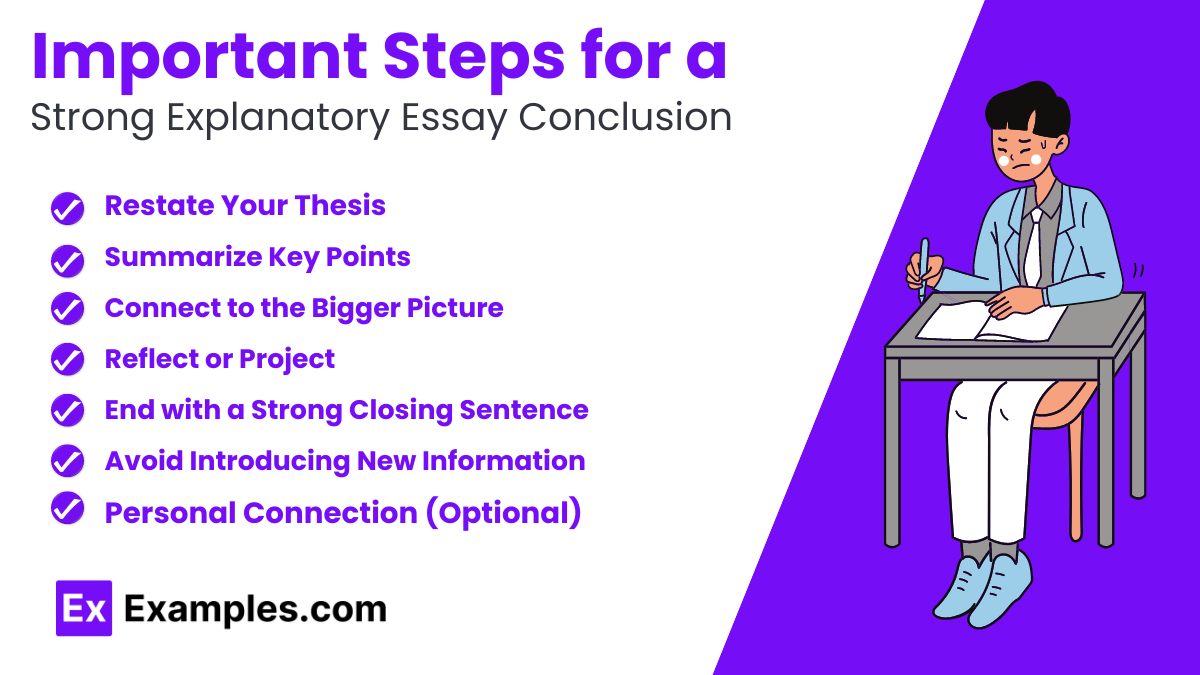
Download This Image
Restate Your Thesis: Start by rephrasing your thesis statement. This reminds readers of the main argument of your essay without repeating it word for word. Ensure it reflects the discussion and evidence presented in your essay.
Summarize Key Points: Briefly summarize the key points you made throughout the essay. Highlight the most compelling evidence and how it supports your thesis. This recap helps readers recall your arguments and reinforces the essay’s overall message.
Connect to the Bigger Picture: Tie your essay’s insights to broader themes or implications. Discuss how your analysis contributes to understanding the topic at a deeper level or its relevance in a broader context. This can involve suggesting how your conclusions might apply to other situations or the implications for future research or policy.
Reflect or Project: Depending on your essay topic, you might choose to reflect on the significance of your findings or project future developments. Reflection can provide personal insights or lessons learned, while projection can speculate on how the topic might evolve.
End with a Strong Closing Sentence: Your final sentence should be memorable. It can be a call to action, a rhetorical question, or a profound statement that leaves the reader thinking. Aim for a closing line that encapsulates your essay’s essence while also pushing the reader to consider its implications further.
Avoid Introducing New Information: The conclusion is not the place to introduce new arguments or evidence. Stick to synthesizing the information already presented in your essay.
Personal Connection (Optional): If appropriate, you can briefly mention what the topic means to you or why it’s important on a personal level. This humanizes your conclusion, making it more relatable and impactful.
10+ Explanatory Essay Samples
- Explanatory Essay on My Favourite Sport
- Explanatory Essay on Road Safety
- Explanatory Essay on Responsibility
- Explanatory Essay on Time Management
- Explanatory Essay on Video Games
- Explanatory Essay on Value of Time
- Explanatory Essay on Tajmahal
- Explanatory Essay on Summer Vacation
- Explanatory Essay on Student Life
- Explanatory Essay on Trees
10+ Explanatory Essay Examples
1. animal explanatory essay.
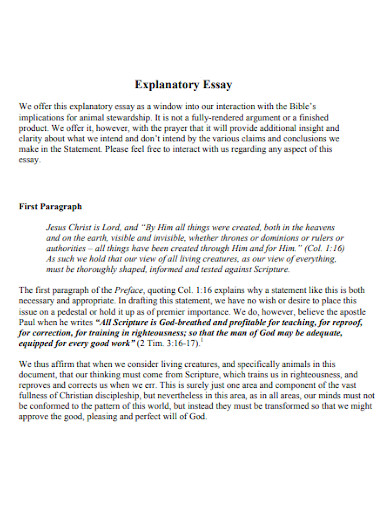
2. Explanatory Essay Checklist
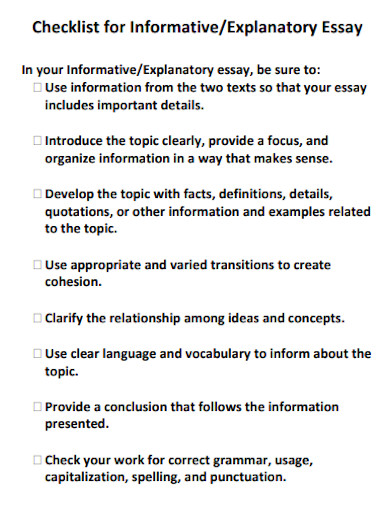
3. Internet Explanatory Essay
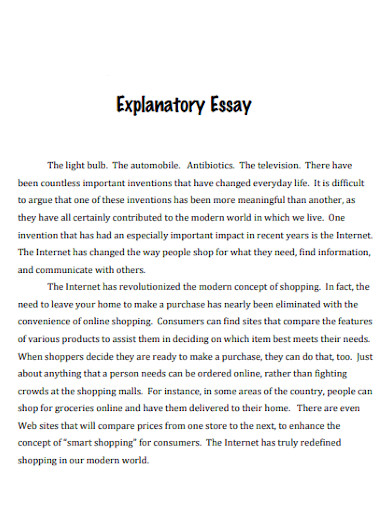
4. Explanatory Synthesis Essay
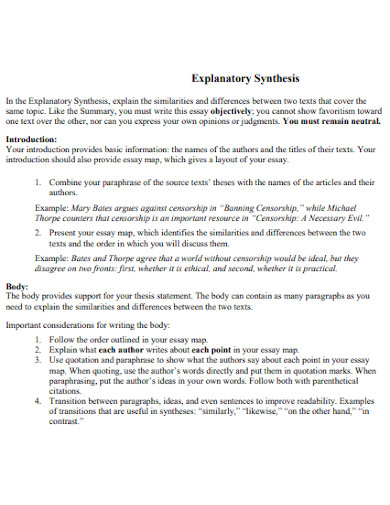
5. Explanatory Essay Sample

6. Informative Explanatory Essay
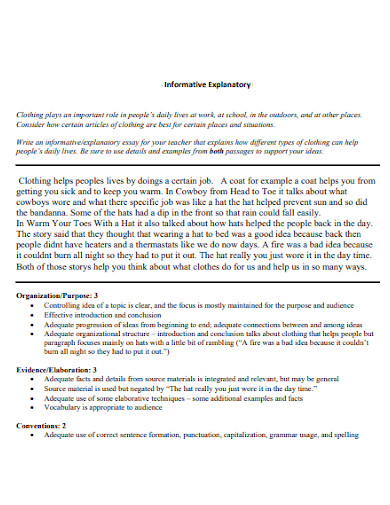
7. Baseball Explanatory Essay
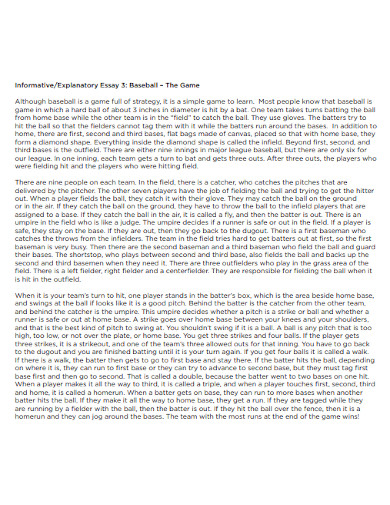
8. Student Explanatory Essay
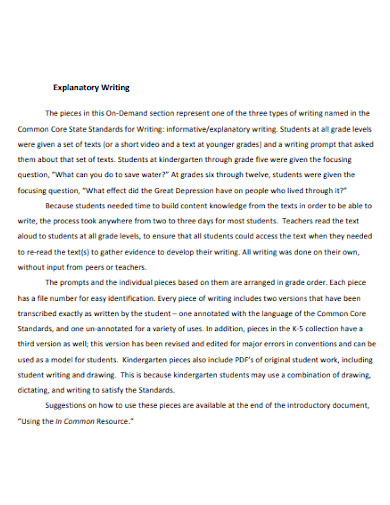
9. Education Explanatory Essay
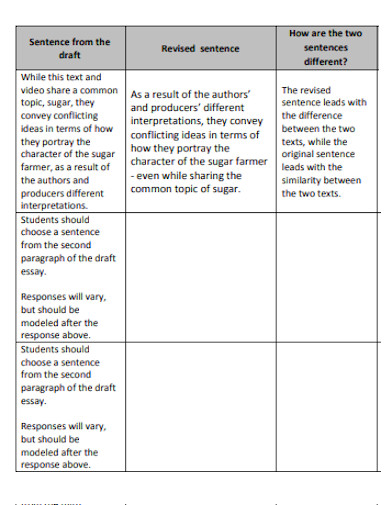
10. Explanatory Essay Analysis
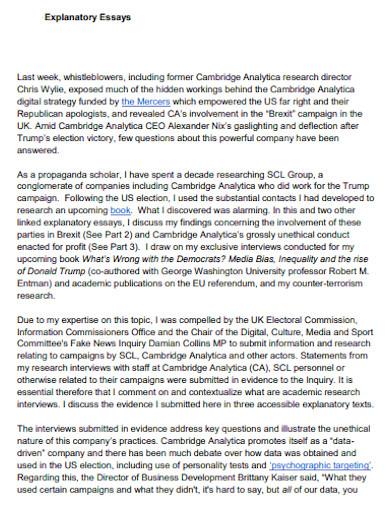
11. Descriptive or Explanatory Essay
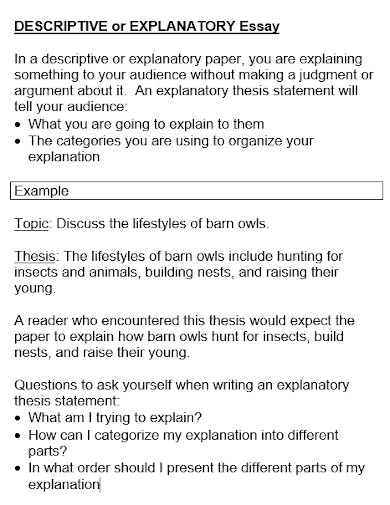
Purpose of an Explanatory Essay
An explanatory essay, often referred to as an expository essay, serves a dual purpose of exploring a topic and informing the audience. Its main goal is to provide a clear and detailed explanation of a subject, idea, process, or set of circumstances, based on facts and devoid of the writer’s personal opinions or biases. This type of essay is fundamental in academic settings as it fosters critical thinking, research skills, and the ability to communicate complex ideas in an accessible manner. Below are the key purposes of an explanatory essay:
- To Inform and Explain: The primary purpose is to educate the reader about a specific topic in a straightforward and logical manner. It aims to break down complex subjects into more understandable segments, ensuring the reader grasitates the full scope and context.
- To Analyze Concepts: Explanatory essays often delve into the analysis of ideas, processes, or phenomena. Through detailed examination, these essays present various perspectives and components of the topic, facilitating a deeper understanding.
- To Provide Clarity: One of the essay’s goals is to clarify any misconceptions or complexities surrounding the subject matter. It seeks to answer questions and resolve any ambiguities, making the topic accessible to all readers regardless of their prior knowledge.
- To Enhance Research and Writing Skills: Crafting an explanatory essay encourages students to conduct thorough research, evaluate sources for credibility, and organize their findings coherently. This process hones their ability to sift through information critically and present it in a structured and compelling manner.
- To Present a Neutral Viewpoint: Unlike persuasive or argumentative essays, the explanatory essay prioritizes neutrality and objectivity. It presents information without taking a stance, allowing readers to form their own opinions based on the facts provided.
- To Encourage Critical Thinking: By analyzing and explaining a topic from multiple angles, explanatory essays stimulate critical thinking in both the writer and the reader. They encourage questioning, exploration, and the synthesis of information into coherent understanding.
When writing the essay, what is best to avoid?
Avoid not editing your work, as well as avoid not doing extensive research. As this kind of essay requires the writer to do their research. Providing the fact and the ideas that an opinion from one writer is not enough to convince the readers. Regardless of what topic you may choose to write, you must have proof.
Is an expository essay and an explanatory essay the same?
Yes. An expository essay is also known as an explanatory essay. However, the term expository is more well known but they are the same type of essay.
This is all the information you may need as you plan to write your essay. Remember to always do extensive research on the topics you choose before you write. As well as ending your essays with a stronger statement or stronger opinion of the topic.
How Do You Write an Explanatory Research Paper?
To write an explanatory research paper, start with thorough research on your topic from credible sources. Organize your findings into a structured outline, categorizing information logically. Write your paper by explaining the research findings clearly, supporting your explanations with evidence, and maintaining an objective tone throughout.
How Do You Start an Explanatory Essay?
Start an explanatory essay with a hook to grab the reader’s attention, followed by a brief introduction to the topic that provides necessary background information. Conclude the introduction with a clear thesis statement that outlines the main points you will explain in the essay.
How Should I Start My Explanatory Essay?
Begin your explanatory essay with an engaging opening sentence or question that piques curiosity. Provide a concise overview or context for the topic, leading smoothly into a well-defined thesis statement that previews the essay’s key points or focus.

Can I Use “I” in an Explanatory Essay?
While it’s generally advised to maintain an objective tone in explanatory essays, using “I” might be acceptable if sharing personal experiences or observations directly relates to explaining the topic. However, this should be used sparingly and only when it enhances the explanation.
What Is the Difference Between Expository and Explanatory Essays?
Expository essays aim to inform and explain a topic to the reader, often involving a thorough analysis or breakdown of a concept. Explanatory essays focus on clarifying or elucidating a specific viewpoint, situation, or event, typically in a more straightforward and less analytical manner. Both share the goal of informing, but their approaches and focuses can vary
Text prompt
- Instructive
- Professional
Write an Explanatory Essay on the process of photosynthesis
Discuss the causes and effects of global warming in an Explanatory Essay
How to research effectively for an explanatory essay.
Crafting a thesis statement for explanatory essays.
Organizing your explanatory essay: Outline essentials.
Writing introductions that captivate in explanatory essays.
Developing coherent body paragraphs in explanatory essays.
Concluding your explanatory essay: Summarizing key points.
Importance of revision in the explanatory essay process.
Citing sources correctly in explanatory essays.
7+ Explanatory Essay Examples That Get the Best Grades

Table of contents

Meredith Sell
Writing explanatory essays is hard, even for experienced scholars.
In this post, I want to try to tackle the major challenges students face when writing this type of essay, using examples of successful essays. These challenges include:
- Struggling to come up with the right idea . (solution: brainstorming techniques )
- Difficulty in organizing the essay. (solution: working on the outline of the essay)
- Not having enough evidence or sources to back up points. (solution: doing proper research )
- Failing to come up with a conclusion. (solution: following our guide to conclusions )
- Not having enough knowledge of the topic. (solution: summarizing key articles on the topic)
- Having trouble finding the right words. (solution: writing with Wordtune )
- Not having enough time to finish the essay. (solution: working on student time management )
- Not being able to present arguments effectively. (solution: learning essay persuasion techniques )
As you can see, for every issue there is the relevant solution, but it takes time to implement it. Another way of tackling this essay is to see other people's essay examples and getting inspiration from them.
Write your explanatory essay faster with this FREE AI tool > Write your explanatory essay faster with this FREE AI tool >

What Is an Explanatory Essay?

If you google “explanatory essay”, you’ll find a bunch of sites saying that an explanatory essay is the same as an expository essay, or that it’s totally different, or not even mentioning that expository essays exist. Who’s right?
Answer: Whoever your professor agrees with.
No, seriously. Your professor decides the parameters of your assignment. So if your professor defines an explanatory essay as one that describes a perspective or analyzes the efficacy of, for example, a local housing policy—that’s the definition you should work from.
But if your professor distinguishes between explanatory essays (which simply explain what something is and how it works or was developed) and expository essays (which expose the reality of a person, place, thing, or idea through investigation and evaluation), you should distinguish between them as well.
For the purposes of this piece, we’re going to use explanatory and expository interchangeably. The dividing line that some draw between these essay types is unnecessarily technical. What’s important is that both:
- Use an objective perspective
- Let the facts speak for themselves
As long as your essay does the same (and includes analysis if required by your professor), you should be in good shape.
Example of explanatory essay
We wrote a whole article on generating essay topic ideas , but here is a good example that can help you get an idea for your own essay:
Why is having a dog as a pet such a wonderful experience?
Dogs are one of the most popular pets in the world. They are beloved companions that bring joy and happiness into the lives of their owners. Dogs have been domesticated for thousands of years and have evolved to become the perfect pet for humans. In this essay, I will explain why having a dog as a pet is a wonderful experience.
One of the primary benefits of having a dog as a pet is the companionship they offer. Dogs are social animals that thrive on human interaction. They are loyal and loving creatures that are always there for their owners. Dogs can help alleviate feelings of loneliness and depression, and provide comfort and support during difficult times.
Another benefit of having a dog as a pet is the health benefits they offer. Studies have shown that owning a dog can help lower blood pressure, reduce stress, and improve overall health. Dogs require daily exercise, which encourages their owners to be more active and can lead to a healthier lifestyle. Additionally, having a dog can boost the immune system and reduce the risk of allergies and asthma in children.
Dogs are also great for families with children. They can help teach children about responsibility, compassion, and empathy. Children can learn to care for and nurture their pets, which can be beneficial for their emotional development. Dogs are also great playmates for children and can provide hours of entertainment and fun.
Training and caring for a dog can also be a rewarding experience. Dogs can be trained to perform a variety of tasks, such as fetching, obedience, and even therapy work. The process of training a dog can help strengthen the bond between the owner and the dog and can be a fulfilling experience. Additionally, caring for a dog requires daily attention and can provide a sense of purpose and fulfillment for the owner.
In conclusion, having a dog as a pet can be a wonderful experience. Dogs offer companionship, health benefits, and can be great for families with children. Caring for a dog can also be a rewarding experience and can provide a sense of purpose and fulfillment for the owner. Owning a dog is a big responsibility, but the rewards far outweigh the effort required.
Example of an explanatory paragraph, generated with AI:

A few subtypes of explanatory essays:
Description or definition essay example
Perhaps the most basic, this subtype does the deceptively simple work of, well, describing or defining a concept, place, person, etc.
Example: How Suspension Bridges Work
This essay explains: The way suspension bridges are constructed and how their design enables them to carry such immense weight.
Cause-and-effect essay example
This type of essay hones in on a particular phenomenon to show what caused it (i.e., where it came from) and how it influences other things.
Example: How Federally Funded Highways Transformed the United States
This essay explains: The history of federally funded highways in the U.S., when federal programs to fund highway construction started, why politicians and others thought highways were important, and what the effect has been on the landscapes, communities, economies, and ecosystems of the country.
Compare-and-contrast essay example
Take two or more things, gather the facts about them, and then write about their similarities and differences.
Example: Hybrid vs. Electric Cars
This essay explains: The various features of hybrid and electric cars, and shows how they are either different or similar in terms of: cost, energy consumption, size, drive time, ease of use, and so on.
How-to essay example
Walk your reader step-by-step through a procedure so they can do it for themselves. (We’re doing this later!)
Example: How to Prepare for an Intercontinental Bike Trip
This essay explains: How to get ready for a bike trip between nations and continents. Readers learn how to research their route, find out what travel documents they need, choose the right gear, and determine how much training they should do before leaving.
Problem and solution essay example
Explain a problem (along with its causes and effects) and then describe one or more potential solutions to that problem. This subtype could also be combined with compare-and-contrast to determine the most effective solution.
Example: How Bike Infrastructure Could Solve American Obesity
This essay explains: How American reliance on motorized vehicles promotes a sedentary lifestyle that drives obesity, whereas building bike lanes and trails could encourage Americans to be more active and improve their health one pedal at a time.
Chronology essay example
Explain the history or backstory of a person, place, thing, or idea in chronological order.
Example: The Evolution of the Bicycle
This essay explains: The initial invention of the bicycle and how its shape, frame, and size changed over the years.
What type of explanatory essay are you writing? Hopefully, this list helped you hone in. Now, let’s start the writing process.
5 Steps to Write Your Essay
Whether you’re writing an explanatory/expository essay or a persuasive essay, the process of researching and writing is pretty much the same. Both genres require research, organization, and thought . But with expository essays, the thought focuses on making sure you understand your topic inside-out and determining the best way to explain it, while with persuasive essays, you’re focused on crafting a convincing argument.
Follow these steps to turn that blank page into a final manuscript:
1. Choose topic and angle.
Do you have free rein to write about the topic of your choice? Make the most of it.
In college, my public speaking professor let us choose all of our own speech topics. A classmate gave an explanatory presentation on how to survive the zombie apocalypse . She brought props and had the class totally enchanted. Our professor encouraged creativity, so I’m sure she earned a winning grade—and had fun in the process.
You can’t use props or sound in a written essay, but you can still work some creative magic. That magic starts with choosing your topic and angle.
To choose well, first make sure you understand the assignment:
- What exactly has your professor asked you to write? Which of the subtypes should your piece be?
- Are there any parameters for what type of topic you can write about?
- What kind of class is this? An English composition class will offer more freedom than, say, a history class focused on the French Revolution.
If you’re allowed to write about anything, brainstorm a list of topics you’re curious about. Then think of smaller topics within that area.
Example: Transportation
- Electric cars
- The highway system
- Engineering
Any of these topics you could easily write volumes about, so next, narrow down to your specific angle. One way I like to come up with angles is to think of how two or three different topics intersect.
Example 1: electric cars + the highway system
Angle: How Much Will It Cost to Update Federal Highways with Charging Stations for Electric Cars
Notice that this angle includes a third element: cost
Example 2: bicycles + bridges
Angle: The Safest Bridges for Bicycles Have One Thing in Common: No Cars
Third element: safety
Example 3: electric cars + buses
Angle: Electric Cars vs. Buses: Which Is Better for the Environment?
Third element: environment
Your turn: Make a list of topics you’re interested in. Then, identify some intersecting topics. Based on your assignment parameters, develop an angle that narrows your focus to an intersection that interests you.
Not sure what angle to go with? Do some broad research on your topics and then return to this step.
2. Research, research, research.
Explanatory essays require solid research. These essays exist to lay out the facts for the reader so they can clearly understand the topic. Your opinion—what you think about electric cars or suspension bridges or transportation infrastructure—doesn’t matter. And it doesn’t belong here.
Where you should start your research depends on how much knowledge you already have.
If you’re writing about suspension bridges and you already know the Brooklyn Bridge and Golden Gate Bridge are suspension bridges, you probably don’t need to start with the encyclopedic entry for “suspension bridges”. But if you don’t know the basic facts about your topic, encyclopedias are a great place to start.
Thanks to the advances of technology—and this marvelous thing called the internet—you don’t have to go to a research library to gain that ground-level knowledge of your topic. But you do still need to make sure you’re drawing from credible sources.
For encyclopedias, try these to start:
- Encyclopedia.com
Dictionaries can be helpful too:
- Merriam-Webster
- Dictionary.com
Once you know your topics’ basic facts, focus on researching those topics in the context of your angle . It may help to make a list of questions you’re trying to answer so you can keep your research focused.
Example: Electric Cars vs. Buses: Which Is Better for the Environment?
- Are most buses gas-powered or electric?
- What’s the average emissions of greenhouse gas from gas-powered buses?
- How much energy do electric cars use? What’s the lifespan of their batteries? Are they just using electricity that was produced in a polluting way somewhere else? What about electric buses?
- How many people can ride a bus? How many people typically are transported by one car?
- What would be the average energy consumption per person in an electric car versus a bus?
Once you know the questions you need to answer, look for sources that address those questions. For an academic essay, you’ll probably want to stick with academic sources : peer-reviewed studies and research papers published by academic journals. But official government databases can also be useful. And news stories from reputable publications can provide some direction as well (check with your professor to see whether or not you can use news publications as sources for your essay). Your educational institution likely provides access to all of these kinds of sources through the university library.
Your turn: Think through your angle and make a list of questions your piece needs to answer. Next, start searching academic databases for the information you need. Take notes as you research, and be sure to save any links, titles, author names, page numbers, and publication information you’ll need to properly cite your sources.
3. Outline your essay.
Call me crazy, but I actually think this is the fun part. I hated writing outlines when I was in school, but since making my living as a professional writer, they’ve become the #1 way I beat writer’s block.
First: Throw out the idea that your outline should be a series of bullet points neatly organized into sections and subsections. Your outline only needs to make sense to you , so play around to find an approach that works with your brain. The idea here is simply to make a map you’ll follow when you sit down to write.
Here’s what I do:
- Identify the specific hook I’m going to use to start things off.
- List the different examples and details I need to include.
- Use the main focus or idea of my piece to order everything in a natural, logical way.
A lot of times, my outline becomes a combination of bullet points and sentences or paragraphs I write as I’m sketching out the piece. I’m basically just thinking the piece through, from beginning to end. Instead of getting stuck while I’m writing, I work through the tough spots in the outlining stage.
This is what my outline looked like for this piece:

Okay, that’s kind of long, so I cut it off early—but you get the point.
A lot of times, my outline starts as bare-bones bullets. As I work on it, ideas pop up that I stick in where they make sense. But when I write, those elements might move around ( notice how the examples of transportation essays got bumped up to the section on subtypes of essays ).
Your outline is just a guide. It’s not an architect’s blueprint that needs to be followed to the exact millimeter. There’s room for things to change.
But an outline keeps you on-track when you’re writing . If you find yourself stuck (or lost) in the writing step, reference your map. You might need to backtrack, move what you’ve written around, or adjust your route.
Your turn: Take a few minutes and sketch out your essay. Where does it start? What points does it hit? Are there any ways you see the different points connecting that should inform how you order them? As you think it through, scribble out any lines or paragraphs that come to you and stick them in the outline where they make the most sense. Even if you don’t use these exact words later, they’ll help prevent that deer-in-the-headlights stare that hits when you see a blank page.
Time to put everything together!
With your outline and research ready, start your intro and set up your piece. Your opening should briefly introduce your readers to the topic(s) you’re writing about and the questions you’re going to answer—but don’t give everything away. You want to stir up readers’ curiosity and give them a reason to keep reading.
Depending on the length of your essay, your intro may be one to three paragraphs long (longer pieces get longer intros). But it should be concise and to the point, and smoothly transition into the body of your essay.
The body is the meat and potatoes of your piece. Answer those questions, flesh out your explanation, and give readers a thorough understanding of your topic. Show off your research! Include those bizarre and fascinating facts you learned along the way. Use a tasteful metaphor or compelling anecdote to explain some of the more difficult aspects of your topic.
As you write, be sure to follow a consistent logic throughout your piece:
- If you’re detailing a history or an event, use chronological order: start at the beginning and write about the events in the order that they happened.
- Are you explaining how a machine or other invention works? Start with where the movement starts—the pedals of a bicycle, the wind turning the turbines—or with the feature doing the most significant work (e.g., the wires of the suspension bridge).
- Other logics include: size (small to large, large to small), significance (greatest to least), or space (left to right, right to left, outside to center, center to outside).
You don’t need to label everything you write about as the “next biggest” or “least significant”, but sticking to a logic helps your readers orient themselves—and helps you determine which paragraph or subtopic should go where. This way, your thoughts clearly flow from one paragraph to the next.
Quick note: If you can’t name the logic that’s guiding your piece, don’t worry. As long as your paragraphs naturally follow each other and all questions raised in the intro are answered by the end, your essay probably follows a logic just fine. But if you feel like your piece bounces around willy-nilly, play with a couple different logics and see if one smoothly orders your sentences and paragraphs.
Your turn: Get writing! If you’re stuck on the intro, try writing a working title for your piece to focus your attention. Then, follow your outline to work all the way from the beginning to a conclusion that sums everything up.
If you can, let your piece sit for at least a day. Then, for the editing process , open up that document and read through with these questions in mind:
- Does the essay fulfill the assignment? Review the assignment description from your professor. Does your essay tick all the boxes? If not, what’s missing? Can you weave that element into what you’ve already written? Revise as necessary.
- Are the sentences and paragraphs ordered in a way that makes logical sense? If your essay feels clunky in places, you might have switched logics (as explained above) or you might need to insert some more explanation that clearly ties the sentences or paragraphs together. Make sure your essay doesn’t just list facts, but also shows how they relate to each other.
- Does the hook catch your eye? The beginning of your piece should grab your reader’s attention. Check out our advice for prize-winning hooks here .
- Does the conclusion effectively sum things up? Instead of repeating everything your essay says, your conclusion should briefly distill the main takeaway or core idea for your reader. It should show that you’ve fulfilled the promise made in your intro, without being unnecessarily repetitive or redundant.
- Have you cited all your sources? Make sure to cross this off before hitting “submit.” Follow the citation style specified by your professor.
- Is spelling and grammar clean and correct? You are writing, after all, and these things matter. A bonus tip to help you catch those sneaky typos: Read your piece backwards. You might be surprised what you spot.
Did We Explain That Well Enough?
This blog was basically a long, non-academic explanatory essay, so hopefully, you’ve learned something new and are feeling less overwhelmed about your essay on medieval literature, transportation infrastructure, Persian history—or whatever you’re writing about.
Share This Article:
%20(1).webp)
8 Tips for E-commerce Copywriting Success (with Examples!)
.webp)
The Brand Strategy Deck You Need to Drive Social Media Results + 5 Examples

Grammarly Alternatives: Which Writing Assistant is the Best Choice for You?
Looking for fresh content, thank you your submission has been received.

IMAGES
VIDEO